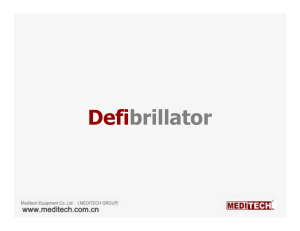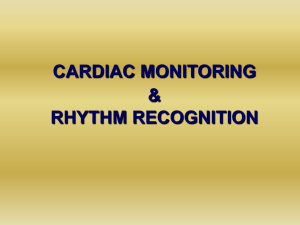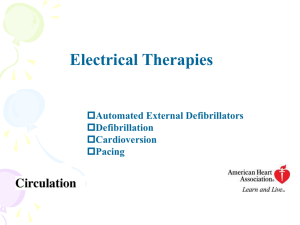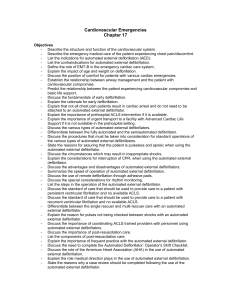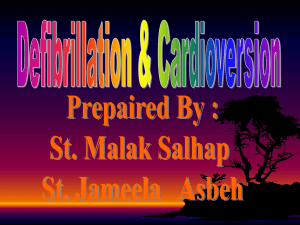Defibrillator
advertisement
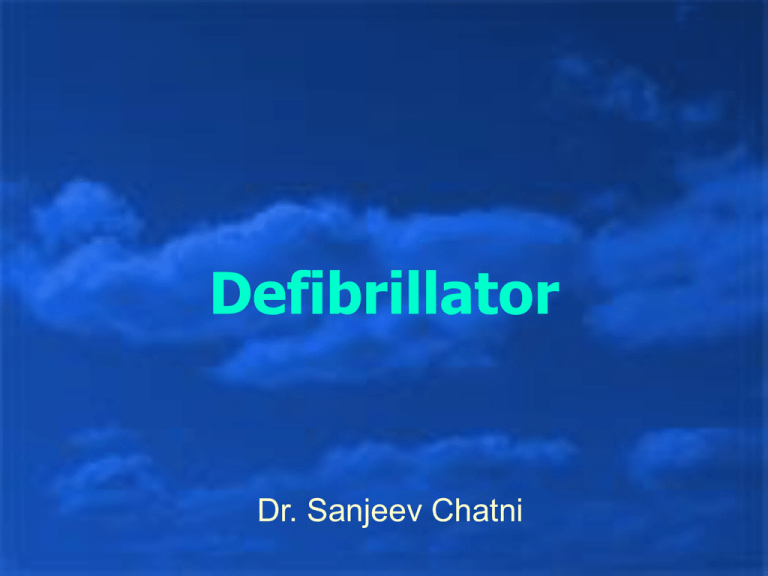
Defibrillator Dr. Sanjeev Chatni Definition An electrical device used to counteract fibrillation of the heart muscle and restore normal heartbeat by applying a brief electric shock Early defibrillation is critical to survival • VF -frequent rhythm witnessed in SCA • Rx for VF is electrical defibrillation • Probability of successful defibrillation diminishes rapidly over time • VF tends to deteriorate to asystole within a few minutes For every minute that passes between collapse and defibrillation, survival rates from witnessed VF SCA decrease 7% to 10% if no CPR is provided Ann Emerg Med. 1993;22:1652–1658 3 actions that must occur within the 1st moment of SCA • Activation of the emergency medical services (EMS) system • Provision of CPR, and • Operation of an AED When 2 or more rescuers are present, activation of EMS and initiation of CPR can occur simultaneously 2 critical questions about CPR+ defibrillation • ? CPR should be provided defibrillation is attempted before • Number of shocks to be delivered in a sequence before the rescuer resumes CPR Shock First Vs CPR First • Out-of-hospital witnessed arrest • If AED is immediately available • Use the AED as soon as possible. Shock First Vs CPR First contd.. In hospital CPR first Out-of-hospital not witnessed SCA 5 cycles of CPR Check the ECG rhythm Defibrillation (Class IIb) • One cycle of CPR consists compressions and 2 breaths of 30 • When compressions are delivered at a rate of about 100 per minute, 5 cycles of CPR should take roughly 2 minutes This recommendation regarding CPR prior to attempted defibrillation is supported by 2 clinical studies JAMA. 2003;289:1389 –1395 JAMA. 1999;281:1182–1188 1-shock Vs 3-shock sequence • No published human studies • Animal studies- 1 shock f/b CPR • VF/ Pulseless VT- 1 shock f/b 5 # CPR • Non shockable rhythm- CPR first • 1st shock efficacy of Monophasic is lower than biphasic shock Defibrillation waveforms and energy levels • The energy settings are designed to provide the lowest effective energy needed to terminate VF • Shock success -Termination of VF for at least 5 sec following the shock • VF frequently recurs after successful shocks, but this recurrence should not be equated with shock failure • Modern defibrillators are classified as Monophasic Biphasic • Energy levels vary by type of device • No specific waveform is associated with a higher rate of return of spontaneous circulation (ROSC) or rates of survival to hospital discharge after cardiac arrest Monophasic waveform Defibrillators • Deliver current of one polarity • 2 types • The monophasic damped sinusoidal waveform (MDS) returns to zero gradually • Monophasic truncated exponential waveform (MTE) current is abruptly returned to baseline (truncated) to zero current flow Biphasic waveform Defibrillators • The optimal energy for termination rate for VF has not been determined • 200 J is safe and has equivalent or higher efficacy for termination of VF than monophasic waveform shocks of equivalent or higher energy (Class IIa) Automated external Defibrillators • AEDs are sophisticated, reliable devices • Use voice and visual prompts to guide lay rescuers and healthcare providers to safely defibrillate VF SCA Lay Rescuer AED programs • 1995 AHA recommended lay rescuer AED programs to improve survival rates from out-ofhospital SCA • Studies of lay rescuer AED programs in airports, & casinos have shown a survival rate of 41-74% from out-of-hospital witnessed VF SCA when immediate bystander CPR is provided and defibrillation occurs within about 3 to 5 minutes of collapse Electrode placement • Right pad – Right Infraclavicular • Left pad – Inf-lateral left chest, lateral to the left breast • Position the pad at least 1 inch (2.5 cm) away from the implantable medical device • Do not place pads directly on top of a transdermal medication patch • If the victim’s chest is covered with water or the victim is extremely diaphoretic, wipe the chest before attaching pads • AEDs can be used when the victim is lying on snow or ice • If the victim has a hairy chest, remove some hair Manual Defibrillation • Both low-energy and high-energy waveform shocks are effective biphasic • Both escalating & non-escalating defibrillators are available energy • Insufficient data to recommend one over another • Use device specific dose • Biphasic- 150-200 J • Monophasic- 360 J • Although operator selects the shock energy (in joules), it is the current flow (in amperes) that actually depolarizes the myocardium Transthoracic Impedance • Human impedance is 70 to 80 Ω • To reduce use conductive materials • In O2 rich areas such as CCU’s arcing has been known to cause fires Electrode size • Min of 50 cm2 • 8-12 cm diameter • Small electrode mat cause myocardial necrosis Fire hazard • In oxygen rich environment • Self-adhesive minimize the risk of sparks • Do not use medical gels or pastes with poor electrical conductivity, such as ultrasound gel Synchronized cardioversion • Shock delivery that is timed (synchronized) with the QRS complex • Avoids shock delivery during the relative refractory portion of the cardiac cycle, when a shock could produce VF • Energy (shock dose) used for a synchronized shock is lower than that used for unsynchronized shocks (defibrillation) • Synchronized cardioversion is recommended to treat • Unstable SVT – d/t reentry – atrial fibrillation – atrial flutter SVT • Monophasic energy for A Fib = 100-200 J • A Flutter = 50-100 J • If initial shock fails then increase dose in step wise manner • Optimal dose for biphasic waveforms not established • Success of terminating A fib with initial dose = 85% Ventricular Tachycardia • Pulseless VT is treated as VF Thank You
